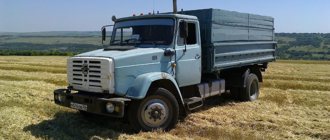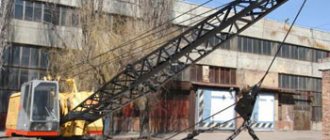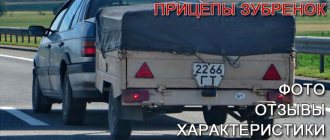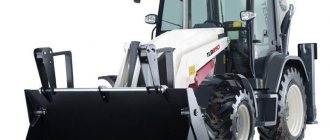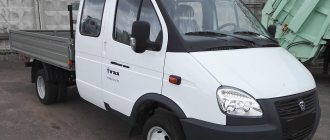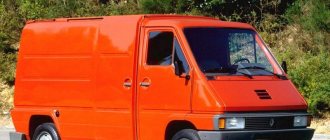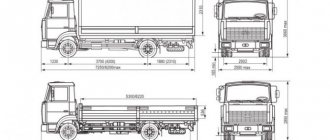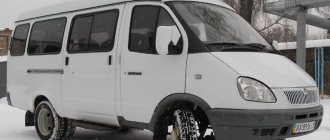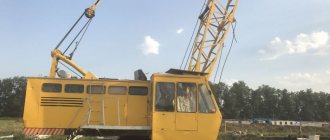Author: Lan, don’t growl
13 October 2015 13:37
Tags: ZIL ZIL 131 test drive
38429
32
It was not easy to drive this car right away. During my first visit to Andrey, the owner of the ZiL, the car was not drivable: the radiator was leaking. Standing in the rain, we agreed to meet a little later. I must admit, I was even a little happy: the weather was in no way conducive to photographing. But when we met again a few days later, the sun was shining, drying up the remnants of puddles and mud on the forest paths.
0
See all photos in the gallery
And again this didn’t suit me a little: I wanted to drive this “baby elephant” into a real wet, impassable mess and - I’ll tell you a secret - see where he could get stuck. We found the absence of a road and real Russian mud (no, not mud, mud!). But it was not possible to “plant” the car in it: the 131st ZIL is an excellent “rogue”. But a couple of dead wood trunks were still crushed, and the glass of the kung was broken. Which, in my opinion, is quite enough to evaluate the capabilities of this brave “warrior”. Go!
Meet ZIL-131
A large army truck, most often with a wooden flatbed body, covered with an awning, with a cab like a Ural and with four rear wheels. The production of these vehicles for the Soviet Army began in 1966 and continued until 1986. From 1986 to 1994, AMO ZIL produced a modernized version of the ZIL-131N, outwardly indistinguishable from its “brother,” running on diesel fuel. Then the model range was replaced by the ZIL-4334 with a modified cabin design. After 1994, the 131st Zilaka was produced at the Ural Automobile Plant until 2002. Then the production baton was taken over by the Novouralsk Automobiles and Motors of the Urals and produced a complete analogue of the truck under the AMUR-521320 brand. Moreover, chassis for various special equipment based on this machine are still produced to this day.
Although these trucks are no longer in mass production, they still make up the active fleet of military units. They can often be seen on Russian roads as part of military transport columns and military parades. By the way, ZIL-131 is not only a canopy board in which people and piece goods are transported. Based on this truck, many different special equipment were produced both for the army and for civilian needs. For example, fire trucks, mobile communication centers, Grad systems, tractor units for strategic missiles, timber trucks, aerial platforms, etc.
One of the significant characteristics of the ZIL-131 is increased cross-country ability. This requirement is justified, because an army truck has to travel not only on paved highways, but also on rough terrain, often damaged by rain and tracks. In accordance with its purpose, the ZIL-131 is equipped with an all-wheel drive transmission and a high ground clearance of 330 mm. Capable of fording a depth of more than a meter and overcoming steep climbs of up to 30 degrees. The carrying capacity of an army truck is not a record, but sufficient to perform the assigned tasks (see table).
The party said: “We must!”
0
In the days from January 27 to February 5, 1959, the extraordinary XXI Congress of the CPSU was held in the meeting hall of the Supreme Soviet of the RSFSR, and the tasks assigned to the delegates this time were significantly different from those at many previous congresses. A seven-year plan for the development of the national economy was discussed, and its peculiarity was the variety of planned goals. This time we did not try with all our might to achieve one thing; we were talking about the comprehensive development of various sectors of the economy. It was at this congress that the historical thesis was announced that socialism had already been built, and it was time to take up communism. It’s not for us to judge whether this was the right decision, but the fact remains: it was necessary to build a bright future, but there was no suitable truck for this. The ZiS-150 is already quite outdated, and no matter how much they tried to modernize the ZiL-157, they still ended up with the ZiL-157 (a good car, by the way, it was put on the production line in 1958 and did not leave it until 1991, we will definitely ride one) . It was necessary to build something new. One of the delegates at the congress was A.G. Krylov is the director of the Likhachev Plant. The team of this enterprise was given the task of slowly replacing the ZIL-164, which had been produced for two years by that time, with the ZIL-130, and at the same time making an off-road truck based on it. The ZiL-130 in the modern sense did not yet exist, but the experimental ZiS-125, which later became the ZiL-130, was ready by 1957. The task, in general, was feasible. But with the 131st we still had to tinker a lot, because the main customer, as usual, was the Ministry of Defense, and this is already serious. Therefore, I will write the well-known stamp “the car saw the light” a little differently: the car saw the light in 1966. I saw it and was horrified. Especially the light that is overseas.
×
ZIL 131 in tables and figures
ZIL-131 and its technical characteristics can be illustrated using the table:
| Curb weight | 6135 kg for modifications with a winch 6375 kg |
| Load capacity | 3.5 t on soil 5 t on hard surface |
| Permissible trailer weight | on the highway 6.5 t on the ground 4 t |
| Cruising range without refueling | 630 km |
| Highway speed | 85 km/h |
| Fuel system | 2*170 l |
| Fuel consumption | average 50 l/100 km |
| Wheel formula | 6:6 |
| checkpoint | 5-speed manual transmission |
Engine parameters:
| Type | Carburetor, 4-stroke, 8-cylinder with heater |
| Fuel type | Petrol |
| Volume | 6 l |
| Power | 150 l. With. or 110 kW |
Dimensions:
| Length from front bumper to rear edge of body | 7040 mm |
| Width | 2500 mm |
| Cabin height | 2480 mm |
| Awning height | 2975 mm |
| Ground clearance | 330 mm |
Known modifications:
| ZIL-131 | Basic (onboard platform) |
| ZIL-131A | Option with unshielded electrical equipment |
| ZIL-131V | Truck tractor for transporting large cargo weighing up to 12 tons |
| ZIL-131D | Military and civilian dump trucks |
| ZIL-131N1 | Version with 105 horsepower diesel engine |
| ZIL-131N2 | This version was already equipped with a 132-horsepower diesel engine |
| ZIL-131S | Version of the truck for the Far North: the cabin had an autonomous heating system, enhanced thermal insulation and double glass; frost-resistant tires were used on the car |
| ZIL-131X | Truck for steppe and desert landscapes, often with appropriate camouflage |
| ZIL-131-137B | Multi-link road train for particularly large shipments |
The best Soviet military truck: the pedigree of the ZIL-131 army vehicle
The three-axle hooded ZIL-131 with all single wheels was the first domestic middle-class army truck with a carrying capacity of 3.5 tons when operating on the ground, which, when operating on paved roads, delivered army cargo weighing up to five tons. Produced for 34 years, the ZIL-131 became the main truck of the Soviet army and the main base of a large family of special military vehicles.
Predecessors of ZIL-131 (1956-1966)
Experimental trucks labeled ZIL-131 appeared in 1956, but then it took a whole decade to bring them to perfection and put them on the assembly line. The stumbling block was the promising V8 power unit, and therefore the three-ton first-born ZIL-131A
received a 135-horsepower V6 engine and units from the ZIS-151, ZIL-157K and the civilian trial model ZIL-130.
The first prototype of the ZIL-131A with a prototype V6 engine and a hatch in the cabin roof. 1956
The result of these combinations was the second 2.5-ton hybrid ZIL-131 with the name ZIL-165
and a six-cylinder engine with 125 horsepower.
In 1959, the third ZIL-131
with a trial V8 engine with a power of 148 hp entered testing, which became the real basis for the future production vehicle.
An intermediate version of the ZIL-165 with a cabin and tail from the trial two-axle vehicle ZIL-130A. 1957
An experimental ZIL-131 truck with a characteristic alligator hood and “predatory” stamped lining. 1959
Production cars ZIL-131 (1966-1990)
The long process of creating the ZIL-131 was completed in December 1966; serial production was launched only a year later. The car was equipped with a 150 hp V8 engine, perfect for its time, shielded electrical equipment, front wheel drive with ball joints, power steering, tire pressure adjustment and an all-metal cabin with a panoramic windshield. A five-ton winch was mounted on some of the vehicles at the front.
Pre-production ZIL-131 with windows on the roof during acceptance tests. 1966 (archive of 21st Scientific Research Center)
The main truck of the Soviet army was the ZIL-131, which did not differ in appearance from its prototypes. 1977 (photo by the author)
During mass production, the ZIL-131 was constantly improved and equipped with new components and small parts, but its external features remained virtually unchanged. In April 1974, the entire family was awarded an honorary state quality mark.
the ZIL-131V truck tractor
with a shortened frame and a semi-automatic coupling device, used for towing semi-trailers with a total weight of up to 12 tons on the highway and 7.5 tons on the ground.
Army truck tractor ZIL-131V of the first production without a winch.
1968 At the end of the 70s, the only and unsuccessful attempt to switch to a new military vehicle was experimental samples of the ZIL-131M
with a multi-fuel V8 engine of 170 horsepower, an extended hood and different versions of the front cladding.
The second version of the ZIL-131M with an overhead valve multi-fuel power unit.
1980 (archive of 21 NIITs) In 1986, the economical basic car ZIL-131N
with a payload of 3.75 tons and an upgraded 150-horsepower engine. Externally, it was distinguished by single blocks of headlights with sidelights, direction indicators on the front fenders and an awning from KamAZ. These most successful vehicles of the 131st family were in fairly high demand in the USSR and entered the armies of socialist and neighboring countries.
The most advanced truck ZIL-131N, produced by ZIL since 1986. Photo by the author, 2011
Partially modified ZIL-131N multi-purpose vehicles in the Finnish armed forces.
1988 Updated truck tractor ZIL-131NV
with an increased load on the coupling device, a front winch and two “spare wheels” behind the cabin as part of road trains, it reached a speed of 75 km/h.
The production of all versions of the 131st ZIL at the Moscow Automobile Plant ended in 1990.
Military variants and equipment on the ZIL-131 chassis
In the Soviet Armed Forces and in the armies of foreign countries, ZIL-131 trucks were used to transport 18-24 people on longitudinal or transverse benches in the back, install army superstructures and tow trailers and small and medium caliber artillery systems.
Column of tilted military trucks ZIL-131N for transporting personnel
ZIL-131N with a trailed howitzer D-30 and a combat crew at a military parade in Khabarovsk (photo by A. Gulyaev)
Adapted to the northern climate, ZIL-131N with a 122 mm D-30 gun in the Finnish army
In the military, trucks were retrofitted with blackout headlights, racks for personal weapons, night vision devices, boxes for military maps, and in a number of countries truss frames were mounted on them for demonstration of missile weapons.
ZIL-131 vehicles at the demonstration of anti-ship missiles of the Sopka complex. 1970
In the 1980s, military plant No. 38 assembled an experimental version of the ZIL-131N serial vehicle for transporting military personnel in the cold season. It was equipped with an autonomous heating and ventilation unit with a chimney mounted between the cabin and the insulated body.
Serial ZIL-131N for delivery of personnel in a body with a heating system. 1987 (archive of 21st Research Center)
The 131B series militarized truck tractors typically operated in conjunction with standard single- and dual-axle semi-trailers designed for the Ministry of Defense and transported large cargo, bridge sections, and bridge construction equipment.
Tractor ZIL-131V with a six-ton semi-trailer OdAZ-9325 with all single wheels (archive of 21 NIITs)
Standard van bodies
Initially, standard military KUNG-1M bodies in several versions were mounted on the ZIL-131. In the late 60s, when the unification of military vans began, the production of sealed frameless structures K-131
and frame-metal
KM-131
with characteristic flat roof slopes, observation windows and life support systems. In addition to various equipment, they could contain crew members for a long time, performing their duties in extreme temperatures, high humidity and in conditions of radioactive contamination.
The most durable frame-metal body KM-131 on the ZIL-131 chassis for equipping repair shops
Radio communication and control equipment
The bulk of the new lightweight, durable and safe bodies, based on the shielded ZIL-131 chassis, were used to accommodate numerous radio communication, radar, reconnaissance and command and control systems, the total number of which reached several hundred versions.
Radio relay station R-409M in the back of K-131, which served in Czechoslovakia under the designation RDM-6. 1975
Priority in this area gradually shifted to autonomous radio relay stations, which created successive sections of army communication lines up to 300 kilometers long. They were equipped with different types of antennas up to 20 meters high, sets of cable reels and their own gas-electric units.
Operational-tactical radio relay station R-419A with telescopic antennas on the roof (photo by A. Melnikov)
The period of the 60–70s was considered the heyday of Soviet mobile radar systems of various powers and purposes. Their basis was considered to be the airfield radar RSP-7T
with a range of 180 km, created for the ZIL-157 car and rearranged for the ZIL-131. It was also used to control the movements of aircraft in the area of airfields and ensure their landing in difficult weather conditions.
Dispatch radar RSP-7T for monitoring aircraft flights
Radar station P-19 "Danube" with a rotating antenna. 1978
In the mid-70s, the P-19 Danube two-coordinate radar station became a development of the previous P-15M system.
on two ZIL-131 trucks with control equipment, a folding rotary antenna device and power supply units. Its purpose was reconnaissance and detection of air targets at different altitudes and ranges of up to 160 kilometers, determining their coordinates, identifying and transmitting information to command posts or anti-aircraft systems.
At the early warning observation station 1L117
For a distance of up to 350 km, two ZIL-131 trucks with special bodies were used, in which the equipment of the transceiver station and the cabin for primary and secondary processing of the received information were mounted.
Vehicle 1L117 with a KUNG-1MD body for processing radar information
the P-37 “Sword” autonomous all-round radar station
, which served to detect air objects and provide air traffic control, included a vehicle on a ZIL-131 chassis with control equipment for the locator operating mode in the body of a KUNG-1M and two-axle trailers with antennas and power plants. The viewing range reached 350 kilometers, the accuracy of determining coordinates was 500 meters.
Indicator vehicle from the P-37R "Sword" radar
Telegraph communication hardware P-241TM in the GDR army (photo by the author)
Less extensive than for the GAZ-66 was the set of military equipment rooms on ZIL-131 trucks with K-131 and KUNG-1M bodies. It included telegraph hardware and communication seal machines for missile systems in seven versions.
Mobile station PU-1
on two vehicles with standard vans it was used to control a division of the 9K72 operational-tactical missile system. They housed work tables, the first Soviet electronic computer for calculating flight missions, a telegraph printing device and a switch, as well as a gasoline-powered electrical unit.
Mobile unit PU-1 with a KUNG-1M body for controlling 9K72 missile systems
Senior staff road train MSh-1 with a head vehicle ZIL-131 and a trailer PSh-1.
1969 (archive of 21 NIITs) The MS-1 complex belonged to high-level mobile command and staff vehicles
based on the ZIL-131 with an all-metal body KM-131, which housed work desks for commanders and operators, shelves and cabinets for documentation, life support systems, power supply, ventilation and heating. The towed trailer PSh-1 contained rest areas for combat crews, a sanitary unit and containers for auxiliary equipment.
Mobile truss ladder FL-95 “Sosna” on ZIL-131 chassis for long-distance radio stations
Lifting the three-section Sosna-2M mast of the R-410M-5.5 radio relay station on the ZIL-131N chassis.
FL-95 Sosna appeared in the category of machines for ensuring the operability of long-distance communications equipment.
with telescopic booms up to 35 meters high, which served for mechanized lifting of transmitting and receiving devices of radio relay and tropospheric communication stations.
Single-section mast supports of the R-410-7.5 tropospheric station based on ZIL-131
Five-section Sosna-M mast of the R-404M3 operational level radio relay station
Such devices were based on ZIL-131/131N trucks with folding legs and sliding telescopic sections up to six meters long, driven by a hydraulic pump operating from the vehicle’s power take-off. To increase stability, cable braces were used to ensure the arrows were in a vertical position at wind speeds of up to 30 meters per second.
The title photo shows the main truck of the Soviet Army, the ZIL-131N medium-duty truck, which was kept in the collection of the Moscow Automobile Plant.
A few words about the cabin and body
The ZIL-131 cab is hooded, all-metal. The interior is made in a harsh Soviet style, without “bourgeois” frills, but with all the necessary functionality. There is thermal insulation, lighting, and an electronic instrument panel. Number of seats - three. The driver's seat and 2 passenger seats are separate, which makes it possible to adjust them independently. The suspension under the cabin is rigid, so it will always shake. If we talk about access to the engine, then in the hooded cabin this is not a problem - you just need to lift the hood lid.
Cabin ZIL 131
The sides of the body are wooden, solid. Loading is carried out through a folding tailgate. If necessary, metal arches are mounted on the body, over which a protective awning is stretched. There are folding benches on the sides for transporting personnel. The set includes a removable bench for 8 people. In total, 24 seats can be arranged in the body.
Body ZIL 131
In the belly of ZiL
0
Despite the decent height, it’s not difficult to climb into the ZIL’s cabin: the handles were under my palms exactly at the moment when I just started to fall, slipping on the metal step. Thanks to them, I still get to the driver's seat of the truck and begin to study the instruments and controls.
0
The first thing we pay attention to is the number of information signs and brief instructions. This was done so that an eighteen-year-old warrior who was drafted here would not immediately go crazy and ruin himself and a piece of equipment. It is interesting that they all address the driver first name, while the operating manual uses constructions such as “the driver must”, “it is necessary for this” or simply “should”. Apparently, the authors quite rightly reasoned that the signs would be read by an ordinary soldier, and the leadership by an officer. Or maybe they were simply saving space on the signs: “turn on” or “close” are written shorter than “turn on” or “close.”
0
0
The instruments are located quite conveniently, and their readings can be read without difficulty. Most of them are familiar to almost any car enthusiast. These are a speedometer, ammeter, coolant temperature, oil pressure and fuel level indicators. The leftmost scale is an indicator of the air pressure in the tires; fortunately, you can deflate or inflate the tires right there: under the device you can see the lever of the valve for controlling this pressure. When driving through swampy places, you can reduce the pressure to only 0.5 kgf/cm2, and on the highway - raise it to 3.5-4. And do it right on the go. The main thing is not to waste too much air! Let's explain why.
0
0
0
0
0
Remember, I said that the most important device on the ZIL panel can be considered a pressure gauge? So, a lot depends on the operation of the pneumatic system, and first of all, the braking system. Here it is pneumatic, not hydraulic, as on most modern passenger cars. The pressure gauge is a two-pointer, its upper part shows the pressure in the air cylinders of the brake system, and the lower part shows the pressure directly in the brake chambers. Cylinder air is used for more than just brakes. It is necessary for inflating tires, for connecting the front axle (it is forcibly connected by a lever from the cab using an electro-pneumatic valve), for a pneumatic sound signal (although there is also an electric one), for driving the windshield wiper blades. But the pressure should never fall below 4 kgf/cm2. As soon as the pressure drops below six, the compressor raises it to 7.3-7.7 kgf/cm2, after which air again begins to be consumed from the cylinders. Everything, in general, is not bad, if not for one “but”: the brakes are designed in such a way that if the pressure drops critically (for example, if a compressor breaks down), they simply fail. It becomes impossible to stop a car whose total weight with cargo can exceed ten tons. There is a parking brake, and it’s not pneumatic, but you can’t stop a heavy truck with it alone. Therefore, the driver has to look at the road with one eye, and with the other, look at the pressure gauge, so that if something happens, he has time to notice an abnormal drop in pressure in the pneumatic system.
0
The main controls are conveniently located. The steering wheel, however, is a bit big, but considering that there is a hydraulic booster, it is very easy to turn it. The pedal assembly was slightly changed: tired of struggling with the gas pedal pulls, Andrey installed the pedal and drive from Mazda. Therefore, now the picture of the pedal assembly looks funny: the harsh clutch pedal goes to the floor, the huge brake pedal is on the floor, and the gas pedal from Mazda suspended from above looks next to them like a college girl in a demobilization car.
0
The gear shift pattern is strange at first glance - the second gear is in the place of the first, and the first is to the right and back, opposite the rear, but this is logical: usually you can start from the second gear. It is interesting that on the knob of the lever there is a diagram on which the rear is indicated simply by an arrow, and not by the more familiar Soviet abbreviation “ЗХ” (“reverse”). But that's it, it's time to go.
Soviet industry no longer exists, but its fruits remain
From 1966 to the beginning of the 90s, more than 1 million ZIL-131 vehicles of various modifications were produced. They were used not only in the Soviet economy and the Armed Forces, but were also widely supplied abroad to support comrades in the socialist camp. You can still see products of the Soviet automobile industry in the countries of Africa and Central Asia. The North Korean army is 100% equipped with Soviet ZILs. Time-tested, these vehicles have proven their durability and suitability for any climatic and road conditions.
How to scare the capitalists?
0
There are two adjectives that can accurately and completely describe the appearance of the 131st ZIL. It's "big" and "green". According to the creators' ideas, it was also supposed to be a little beautiful, but the stern people in the uniform of the Soviet Army did not have such a fine mental organization to be imbued with respect for a complex-shaped radiator grille or stamped wings with smooth contours. They considered that straightening them in case of damage would take too much time and effort, and therefore advised to simplify some of the body elements. Let's give credit to the ZiL designers; they still managed, although they made the “tin can” simpler, to retain a certain amount of elegance. And only the slanted protective grilles on the car’s headlights make his look sad and say: “I could be more beautiful!” Don’t be sad, little elephant, you’re nothing at all for a military vehicle. Although it looks like a Studebaker from the early forties or an International Harvester, which, of course, is a pure coincidence. However, beauty is not the most important thing in a truck. It’s better to pay attention to the details visible to the naked eye.
0
The huge front bumper has corrugation on its upper platform. This is done for convenience, because only by standing on it can you reach the engine compartment; you cannot reach the engine compartment from the ground. But you can immediately see the orange “flashing light” on the roof, the retractable antenna on the kung and some other details. To explain these features of our truck’s configuration, let’s look at the history of its acquisition.
0
0
0
0
0
This ZIL spent his youth serving in the army. Then he ended up in one office, which we will not name, and only from there - into the hands of Andrei. It just so happened that even the exact year of production of this car could not be established (apparently a military secret), the exact mileage is also unknown: the speedometer and documents were replaced before the sale of the car. And Andrei needed the ZIL itself as a “technician”. The fact is that in addition to this truck, the car enthusiast also has another car, namely the Jeep Wrangler, which is actively used in racing. Just for the competition, a technical assistance vehicle was needed. Not every car can get to where a prepared Wrangler can go, so the choice fell on the 131st ZIL. In his kung you can easily transport a bunch of tools, a generator and a lot of other useful equipment. You can also carry people in the booth, because there is a “stove” there, and you can ride in relative comfort. Therefore, from time to time the car and its owner are contracted to work as a “shift” for people who need to drive into hard-to-reach places.
0
Since sometimes you have to drag a combat Wrangler along with you on a rigid hitch, an orange “flashing light” was installed, which proved to be much more reliable than the standard lights of a road train (these are three lights on the roof). An antenna is necessary for organizing communications: there is a GSM repeater in the kung, which allows you to stay in touch in the wildest places. Well, a winch will never hurt such a car. What other interesting things can you see outside? Probably nothing else significant. Except that there are two gas tanks on both sides of the car. Fuel consumption here is very decent: about 50 liters per hundred kilometers, so the tanks are appropriate - 170 liters each. Just for fun, let’s do the math: 170 x 2 = 340 liters. Let gasoline cost 34 rubles, then we get 11,560 rubles. And this is for one gas station. And, importantly, 650 kilometers along the route. However…
0
To be completely precise, the operating manual indicates a reference fuel consumption of 40 liters per hundred and a corresponding range of 850 kilometers. In fact, of course, everything is much worse. Let's see where all that gas goes. And it goes into an eight-cylinder V-shaped engine, the volume of which is almost six liters. But it produces only 150 horsepower. And if, thanks to the downshift in the transfer case, this truck moves quite well off-road, then on the highway the acceleration is not very impressive. But we are interested in off-road. Maximum power is achieved at maximum speed (3,200), and maximum torque of 410 Nm is available already at 1,800-2,000 rpm. For those who have been staring for several minutes in the hope of finding at least a little bit of cast iron and aluminum data, we inform you: the cylinder block here is cast iron, with “wet” liners, but the cylinder heads (there are two of them) are cast from an aluminum alloy. The steel camshaft is driven by gears and operates the valves (they are on top) through pushrods, rods and rocker arms.
0
The gearbox is five-speed, and all gears except the first have synchronizers. There is, of course, a transfer case with two gears. We will consider the subtleties of the joint work of the ZiL gas guzzler and transmission units a little later. Now let’s sit in the cockpit and from there look at the pressure gauge and find out why this particular device can be called the most important in ZIL.
Let's hit the ZIL off-road!
0
In front of us, a second-generation Cherokee is climbing along the forest path, and I’m following behind in a ZIL. And you know, this rather large jeep walking in front of me seems like a small insect. My task is not to accidentally crush this insect. Avoid potholes and puddles? What for! Moreover, on this narrow road it was not so easy for me to even hold the truck. The steering wheel play, even according to the passport, can reach 25 degrees. And taking into account the fact that the car is crawling on a washed-out road and scraping it with three drive axles, control becomes a difficult thing. At least not without proper experience. Having reached the place where Cherokee wisely stopped, we move on. Even in second gear, the ZIL creeps along slowly and is already asking to put it in third. And all because the low gear was turned on, because, in general, there was no road anymore. A light on the panel lights up, indicating that the front axle is connected. On the way, I manage to appreciate the need for hatches in the cabin roof: with the side windows down, it’s very easy to get hit in the face with a tree branch. This is where you have to close the windows and open the hatches: there is fresh air, but there is no threat of getting hit in the face by a vengeful birch or aspen. However, here it is, the first obstacle: trees lying across the road. I even managed to get upset: how could it be, we just started! But, as it turned out, a pair of guns for a ZIL are matches. He moved and barely twitched. True, I had to engage first gear.
0
0
By the way, about switching. This lever could probably easily kill a person. The seating position in the car is high (otherwise you simply won’t see anything because of the huge hood), so the gearshift lever is very long. The move is expected to be large, but this is not the main thing. The trick is that the speed is switched on almost immediately, there is no need to miss or stick into gear with effort and grinding. Except, perhaps, the first one. But here the dog is buried, as I think, in the absence of a synchronizer in this gear. ZiL can be forgiven for such a trifle. When turning on the patch, we very successfully drove the rear axles into a small ravine. The axles stood at an unnaturally large angle, but our “baby elephant” made no attempt to lie on its side. He stood obediently, bending over like a barn cat trying to catch a flea on its own scruff. The only thing that was damaged was the glass of the kung, which apparently was broken on a thick tree branch, or maybe even on a trunk. I didn't have to take a photo of the truck lying on its side, which is good. Well, we sat behind the wheel, we were shocked in the passenger seat, it’s time to ride in the kung.
0
0
0
Kung. What a strange word. Have you ever wondered where it came from? Some may think that this is some kind of borrowing from a foreign language, but this is not so. “KUNG” is an abbreviation for “uniform body of zero (normal) dimensions.” And this term appeared just here, or rather, in the army. The first kungs were installed on ZIL-157 and 131, and then on GAZ-63, GAZ-66, KAMAZ-4310, Ural-375. What’s good about a kung is that it’s more pleasant to drive in than in an open body or under a regular tarpaulin. There is no heating, no wind, sit and enjoy. But it was not there. On any decent bumps (and we drove over a lot of them), the kung is thrown from side to side. You have to grab onto everything that is more or less motionless, rest your feet on the floor and protect your head. I didn't like it there at all. Although, I think, at minus twenty-five I would have climbed there with pleasure, so usually a kung gun is an irreplaceable thing.
0
0
Features and modifications of the truck
Work on creating a mass-produced truck began in the early 50s of the last century. And the first prototype was presented in 1956. But it was not possible to immediately start production of the car, although it successfully passed the necessary tests. At first, the “tops” scheduled the release of the new ZiL for 1961, but it didn’t work out. And the first batch of cars rolled off the assembly line only in 1966. The ZIL-131 was developed on the basis of the “one hundred and thirty” and with its appearance was supposed to retire the 157th model , which was already very outdated. The new truck was superior to its predecessor in all respects: comfort, carrying capacity, cross-country ability and speed.
The ZIL-131 received a universal chassis, which contributed to, let’s say, a creative flight of thought. Therefore, the “one hundred and thirty-first” quickly received several modifications. Firstly, the traditional one is onboard. A classic truck with a wooden body and a metal frame. Along the sides of the body there were folding benches that could accommodate 16 people. Secondly, Zil-131 manipulator. Since the design was based on carbon steel, the truck could be fitted with cranes or other special equipment without fear. Thirdly, a dump truck. But this variation, as they say, did not catch on. It’s difficult to say what caused this, but after producing several copies, the production of dump trucks was curtailed.
Regardless of the modification, all ZIL-131s amazed with their off-road capabilities. The trucks received an innovative axle, 8-ply tires with a special tread pattern and a center differential. Thanks to this “arsenal,” the off-road vehicle could compete even with tracked vehicles. The military appreciated the truck's capabilities. Therefore, the ZIL-131 was used to install various weapons. For example, "Katyusha". In addition, the truck was well suited for transporting stations, radio communication points, and so on. The “one hundred and thirty-first” was also used in aviation services. In civilian life, the truck was used for street cleaning, transporting gasoline tanks, and also for non-fire service.
